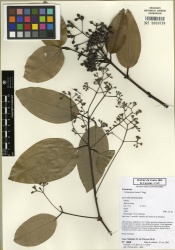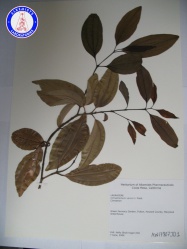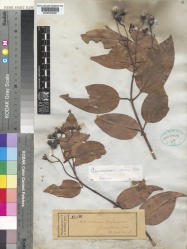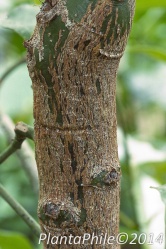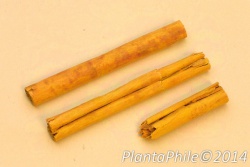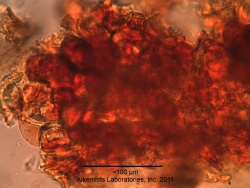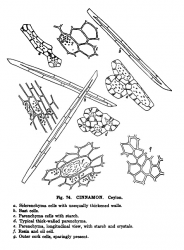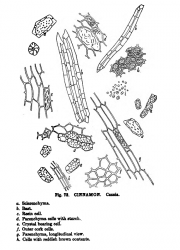Cinnamomum verum (bark)
(schneider entry) |
(add Culbreth ref for macro, micro) |
||
| (22 intermediate revisions by 4 users not shown) | |||
| Line 1: | Line 1: | ||
| − | {{Botanical | source=Schneider, A. (1921) The Microanalysis of Powdered Vegetable Drugs, 2nd ed. | + | {{DISPLAYTITLE:''Cinnamomum verum'' (bark) }} {{askbox|herb=''Cinnamomum verum''}} |
| − | + | =Nomenclature= | |
| − | + | {{nomenclature | binomial=Cinnamomum verum | |
| + | |authority=J. Presl | ||
| + | |family=Lauraceae | ||
| + | |scn=cinnamon | ||
| + | |syn= | ||
| + | |ayurvedic=tvak | ||
| + | |pinyin= | ||
| + | |aka=Ceylon cinnamon; true cinnamon | ||
| + | |notes=}} | ||
| + | |||
| + | =Botanical Voucher Specimen= | ||
| + | {{Media3 |cat=Voucher | ||
| + | |||
| + | | source=MOBOT, Tropicos.org | ||
| + | | mainimage=Cinnamomum verum Tropicos 100003409.jpg | ||
| + | | companyimage=TropicosLogo.gif | ||
| + | | companyURL=http://www.tropicos.org/Image/100003409 | ||
| + | | reference=Tropicos.org. Missouri Botanical Garden. 19 Mar 2014 <http://www.tropicos.org/Image/100003409> | ||
| + | |||
| + | | source2=Botanical Voucher Specimen Library, Alkemists Laboratories | ||
| + | | image2=Cinnamomum verum AW17807JD1 A0075.jpg | ||
| + | | companyimage2=AP-LOGO-Laboratories Crop - Copy.jpg | ||
| + | | companyURL2=http://www.alkemist.com | ||
| + | |||
| + | | companyimage3=Kewlogo.gif | ||
| + | | companyURL3=http://specimens.kew.org/herbarium/K000350931 | ||
| + | | image3=Cinnamomum_verum_Kew_imageBarcode=K000350931_44160.jpg | ||
| + | | source3=Royal Botanic Gardens, Kew. | ||
| + | |||
| + | |||
| + | | }} | ||
| + | |||
| + | =Organoleptic Characteristics= | ||
| + | {| border=1 | ||
| + | | | ||
| + | {{Macroscopy | source=Schneider, A. (1921) The Microanalysis of Powdered Vegetable Drugs, 2nd ed. | ||
| + | |description= | ||
| color=Rather light cinnamon brown (reddish brown). | | color=Rather light cinnamon brown (reddish brown). | ||
| flavor=Sweet, pungent, slightly astringent. | | flavor=Sweet, pungent, slightly astringent. | ||
| − | | scent=Delicately fragrant and aromatic. | + | | scent=Delicately fragrant and aromatic.}} |
| − | | characteristics=Histology much like that of [[Cinnamomum_aromaticum_(bark)|Cassia Cinnamon]]; bast cells are more abundant and the cells of the outer cork wanting; starch less abundant. It is possible to distinguish this cinnamon from the other two by the larger sclerenchyma cells and absence of outer cork and epidermal tissues. | + | {{Macroscopy | source=Culbreth, D. (1917) A Manual of Materia Media and Pharmacology, 6th ed. |
| + | |description= | ||
| + | | flavor=Sweetish, warmly aromatic. | ||
| + | | scent=Agreeably aromatic.}} | ||
| + | |} | ||
| + | =Macroscopic Characteristics= | ||
| + | {| border=1 | ||
| + | | | ||
| + | {{Macroscopy | source=Culbreth, D. (1917) A Manual of Materia Media and Pharmacology, 6th ed. | ||
| + | | description='''Plants:''' Handsome evergreen trees, 6-9 M. (20-30°) high, truck .3-.5 M. (12-18') thick, young twigs slightly quadrangular; leaves coriaceous, 3-5-nerved, but only midrib reaches apex, bright glossy-green above, glaucous beneath, 10-20 Cm. (4-8') long; flowers Jan.-March, small, hermaphrodite or polygamous, fleshy, black, ovoid, size of small olive, adhering, like acorn, to cup-shaped perianth. | ||
| + | |||
| + | '''Bark:''' (''C. zeylanicum''): ''Ceylon'' [Syn. ''Cinnamomum (acutum) verum''], in closely rolled double quills of 7-12 thin layers of separate pieces of bark, 30-50 Cm. (12-20') long, 8-13 Mm. (1/3-1/2') broad, bark 1 Mm. (1/25') thick, pale yellowish-brown, smooth, longitudinally striate with narrow groups of bast-fibres and brownish patches, occasional perforations marking the nodes, inner surface light brown, with faint longitudinal striations; fracture short with projecting bast-fibres. | ||
| + | }} | ||
| + | {{ Media2 | cat=Macroscopy | ||
| + | | source=PlantaPhile | ||
| + | | mainimage=PlantaPhile - 899.jpg | ||
| + | | companyimage=PlantaPhile logo.jpg | ||
| + | | companyURL=http://plantaphile.com/ | ||
| + | |||
| + | | source2=PlantaPhile | ||
| + | | image2=PlantaPhile - 259.jpg | ||
| + | | companyimage2=PlantaPhile logo.jpg | ||
| + | | companyURL2=http://plantaphile.com/ | ||
| + | | }} | ||
| + | |} | ||
| + | =Microscopic Characteristics= | ||
| + | {| border=1 | ||
| + | | | ||
| + | {{Microscopy | source=Schneider, A. (1921) The Microanalysis of Powdered Vegetable Drugs, 2nd ed. | ||
| + | | characteristics=Histology much like that of ''[[Cinnamomum_aromaticum_(bark)|Cassia Cinnamon]]''; bast cells are more abundant and the cells of the outer cork wanting; starch less abundant. It is possible to distinguish this cinnamon from the other two by the larger sclerenchyma cells and absence of outer cork and epidermal tissues. | ||
| ash=Ash 4 per cent. | | ash=Ash 4 per cent. | ||
| adulterants=Adulterations as for Cassia cinnamon; inferior cassia barks, clove bark, flour, inert vegetable substances. | | adulterants=Adulterations as for Cassia cinnamon; inferior cassia barks, clove bark, flour, inert vegetable substances. | ||
| }} | | }} | ||
| + | {{Microscopy | source=Culbreth, D. (1917) A Manual of Materia Media and Pharmacology, 6th ed. | ||
| + | | description=Powder, yellowish-brown; microscopically--numerous starch grains, 0.003-.02 Mm. (1/8325-1/1250') broad, colorless stone cells, numerous cellular reddish-brown fragments, calcium oxalate raphides; ''Saigon'' has many cork cells, ''Ceylon'' [Ed-Syn. ''verum'' in text] few or none, while bast-fibres of former are in groups of 2-20, of latter single and fusiform. | ||
| + | | adulterants=Bark: 1, ''Cassia'' bark, and a closely resembling bark of unknown derivation, having lighter gray color and coarser structure identified by weak odor and taste; possibly unscraped ''Guava'' bark quills, and clove bark; 2, Scarcely possible in the entire state; Powder: That of either variety not found on the market, all so labeled being cassia, which is subject to endless admixtures--chips, siftings, buds, walnut-shells, oil stone, flour, sand, beans, grains, starch, clove buds--exhausted drug, by percolation, distillation; ash (sometimes) 8-10 p. c.; Oil: That distilled from flowers and roots, phenol, oil of clove, petroleum, colophony, lead. | ||
| + | }} | ||
| + | |||
| + | {{Media2 |cat=Microscopy | source=Elan M. Sudberg, Alkemist Laboratories | ||
| + | |companyimage=AP-LOGO-Laboratories Crop - Copy.jpg | ||
| + | | companyURL=http://www.alkemist.com | ||
| + | | source2=Elan M. Sudberg, Alkemist Laboratories | ||
| + | |companyimage2=AP-LOGO-Laboratories Crop - Copy.jpg | ||
| + | | companyURL2=http://www.alkemist.com | ||
| + | | mainimage=Cinnamon 1.jpg | ||
| + | | caption1=Thick walled fiber when observed at 400X with Acidified chloral Hydrate Soln. | ||
| + | | description= Ceylon cinnamon (bark) (''Cinnamomum verum'') | ||
| + | | image2=Cinnamon 2.jpg | ||
| + | | caption2=Large resin cells showing dark red contents observed at 400X with Acidified chloral Hydrate Soln. | ||
| + | | reference=British Pharmacopoeia, 2003 | ||
| + | | }} | ||
| + | {{Media3 |cat=Microscopy | source=Schneider, A. (1921) The Microanalysis of Powdered Vegetable Drugs, 2nd ed. | ||
| + | | source2=Schneider, A. (1921) The Microanalysis of Powdered Vegetable Drugs, 2nd ed. | ||
| + | | source3=Schneider, A. (1921) The Microanalysis of Powdered Vegetable Drugs, 2nd ed. | ||
| + | | mainimage=Microanalysis_powdered_vegetable_google_ver_cinnamon_verum.png | ||
| + | | caption1=Ceylon Cinnamon (powdered bark) (''Cinnamomum verum'') / (''Cinnamomum zeylanicum'' Nees) | ||
| + | | description=Ceylon Cinnamon (bark) (''Cinnamomum verum'') / (''Cinnamomum zeylanicum'' Nees) | ||
| + | | image2=Microanalysis_powdered_vegetable_google_ver_cinnamon_cassia.png | ||
| + | | caption2=Compare to ''[[Cinnamomum_aromaticum_(bark)|Cinnamon aromaticum]]''. | ||
| + | | image3=Microanalysis_powdered_vegetable_google_ver_cinnamon_loureiroi.png | ||
| + | | caption3=Compare to ''[[Cinnamomum_loureiroi_(bark)|Cinnamon loureiroi]]''.}} | ||
| + | |} | ||
| + | =High Performance Thin Layer Chromatographic Identification= | ||
| + | |||
| + | =Supplementary Information= | ||
| + | =Sources= | ||
| + | |||
| + | <references /> | ||
Latest revision as of 16:42, 2 June 2015
Contents |
Nomenclature
Cinnamomum verum J. Presl Lauraceae
Standardized common name (English): cinnamon
Ayurvedic name(s): tvak
Botanical Voucher Specimen
 |
 |
|
|
|
|
|
Organoleptic Characteristics
|
Macroscopic Characteristics
|
Microscopic Characteristics
|
High Performance Thin Layer Chromatographic Identification
Supplementary Information
Sources
- ↑ MOBOT, Tropicos.org http://www.tropicos.org/Image/100003409
- ↑ Botanical Voucher Specimen Library, Alkemists Laboratories http://www.alkemist.com
- ↑ Royal Botanic Gardens, Kew. http://specimens.kew.org/herbarium/K000350931
- ↑ Schneider, A. (1921) The Microanalysis of Powdered Vegetable Drugs, 2nd ed.
- ↑ Culbreth, D. (1917) A Manual of Materia Media and Pharmacology, 6th ed.
- ↑ Culbreth, D. (1917) A Manual of Materia Media and Pharmacology, 6th ed.
- ↑ PlantaPhile http://plantaphile.com/
- ↑ PlantaPhile http://plantaphile.com/
- ↑ Schneider, A. (1921) The Microanalysis of Powdered Vegetable Drugs, 2nd ed.
- ↑ Culbreth, D. (1917) A Manual of Materia Media and Pharmacology, 6th ed.
- ↑ Elan M. Sudberg, Alkemist Laboratories http://www.alkemist.com
- ↑ Elan M. Sudberg, Alkemist Laboratories http://www.alkemist.com
- ↑ Schneider, A. (1921) The Microanalysis of Powdered Vegetable Drugs, 2nd ed.
- ↑ Schneider, A. (1921) The Microanalysis of Powdered Vegetable Drugs, 2nd ed.
- ↑ Schneider, A. (1921) The Microanalysis of Powdered Vegetable Drugs, 2nd ed.
- Botanical
- Lauraceae
- Media
- Voucher
- MOBOT, Tropicos.org
- Botanical Voucher Specimen Library, Alkemists Laboratories
- Royal Botanic Gardens, Kew.
- Macroscopy
- Schneider, A. (1921) The Microanalysis of Powdered Vegetable Drugs, 2nd ed.
- Culbreth, D. (1917) A Manual of Materia Media and Pharmacology, 6th ed.
- PlantaPhile
- Microscopy
- Elan M. Sudberg, Alkemist Laboratories
